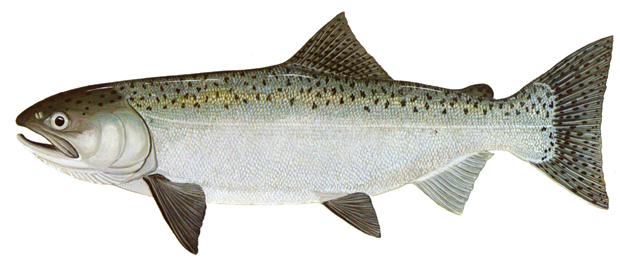
STEELHEAD TROUT Oncorhynchus mykiss
Steelhead spread their spawning migrations over a long period, historically entering streams throughout the year. Like the Chinook, there are currently at least 2 distinct run types left: Summer and Fall Steelhead. Summer steelies return to the river sexually immature beginning in April and hole up in deep pools of cold tributary streams until late fall/winter to commence spawning. They share the same needs as Coho for the smaller size spawning streams, but tend to go higher upstream. Winter steelhead populations have not been as well documented but we know they usually reenter the river between Dec. and Mar. and usually spawn immediately upon returning. Fingerling steelhead remain in the freshwater longer than our other salmonids, migrating out to the ocean after 2, or even 3, years. Half-pounders are small, sexually immature steelhead that return to freshwater after spending less than a year in the ocean; these populations are unique to Northern CA, Southern OR populations. Recent studies show that some native rainbow trout become steelhead under certain conditions. Steelhead populations on the Pacific west coast have been steadily declining for the last 30 years, with the summer run being very low. The 2000/2001 season for winter run steelhead was more promising.
SPRING CHINOOK (King) SALMON
Oncorhynchus tshawytscha
-A RUN UNIQUE TO THE SALMON RIVER
Spring run chinooks were
once the most abundant salmon in CA and in the Klamath Basin. The Upper
Klamath Basin was once the most prolific areas for spawning. Inter-tribal
world renewal ceremonies at the mouth of the Salmon River (or Katamin “the
Center of the World”) historically insured that the spring salmon made it to
the spawning grounds in the upper reaches in the Basin. Today the state-wide
annual run totals of wild “Springers” can be less than 1000 fish in some
years and exists only in the Sacramento and Klamath Basins. This almost
extinct run is thought to be low due to two main causes. One reason is that
by 1910 canneries at the mouth of the Klamath River had seriously depleted
the numbers. The second reason is that seven dams in the mid-upper Klamath
completely block all access for fish to the Upper Basin which is thought to
be the most used spawning habitat historically. In the last 20 years the
spring chinook count in the Salmon River averaged only 600 fish, with the
total count being less than 200 in two different years. The 2000 run of fish
was 222, which is the lowest year since 1980. Although current genetic data
identifies fall and spring chinook as the same species, these runs have
significantly different life history and habitat needs. Some of the
differences between spring and fall chinook include, Springers: 1) Enter the
river from late spring/summer prior to full maturity; 2) During the summer
they move upriver and wait out the summers in the in the coolest waters,
deepest pools and best hiding places; 3) Spawning occurs earlier in the fall
during Sept/Oct; 4) Use spawning and rearing habitat higher up in the
system; 5) Juveniles mature slower in the colder headwaters and fry stay in
the river longer. The juveniles head out to sea where they mature to be the
largest salmon, averaging 20 lbs. Not enough is known about these fish to
confidently predict the big problems. More attention should be given to the
Salmon River Spring Chinook which is currently listed as a “sensitive”
species by the USFS in Region 5 (CA). A Spring Chinook Recovery Plan was
developed by concerned parties in 1991 to help these fish. Many feel that
with the numbers being so low we need to reopen the plan and update it as
needed.
FALL RUN CHINOOK (King) SALMON Oncorhynchus tshawytscha
Fall chinooks enter the river from the end of summer through fall with a late run continuing until Feb. Our fall chinook spawning is at its peak in Oct. and Nov. Shortly after emerging, young chinook make their way slowly down river. By June, as the water level drops, the fingerlings are well on their way to the ocean where they feed for 2-5 years before beginning the cycle again. Both chinook and coho die after spawning. These fish are regulated by the Dept. of Fish & Game.
COHO (Silver) SALMON Oncorhynchus kisutch
The red-sided, green-backed coho salmon arrive in alarmingly small numbers to spawn in only a few of CAs’ rivers from Sept~Nov before spawning in Oct~Jan. They’ll spend one season smolting (a change necessary to enter saltwater) and usually two seasons in the ocean before they return to their spawning ground. Coho often spawn in tributaries that flow only in winter. They are smaller and more agile than the chinook; then travel higher up in the system and use the smaller tributaries, underscoring the importance of even the smallest creeks. Juvenile coho and steelhead juveniles rearing in the same small streams tend to use different areas of the creek. Coho are known to stay in the margins or edge of the streams and prefer slower water. After gravitating downstream they’ll be found in tight schools nearer the surface than steelhead. This species was listed as an “Endangered” species in 1998 and is afforded extra protection.
Back to Salmon River Fishery Back to Contents